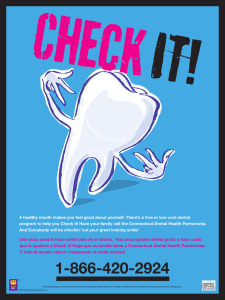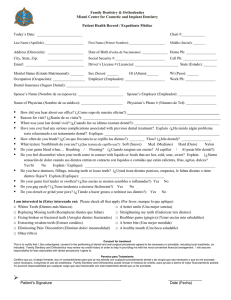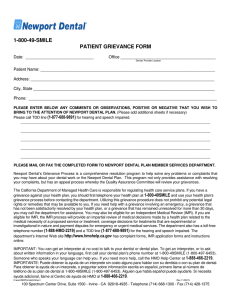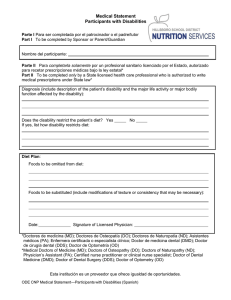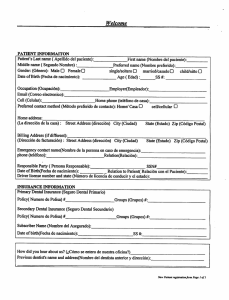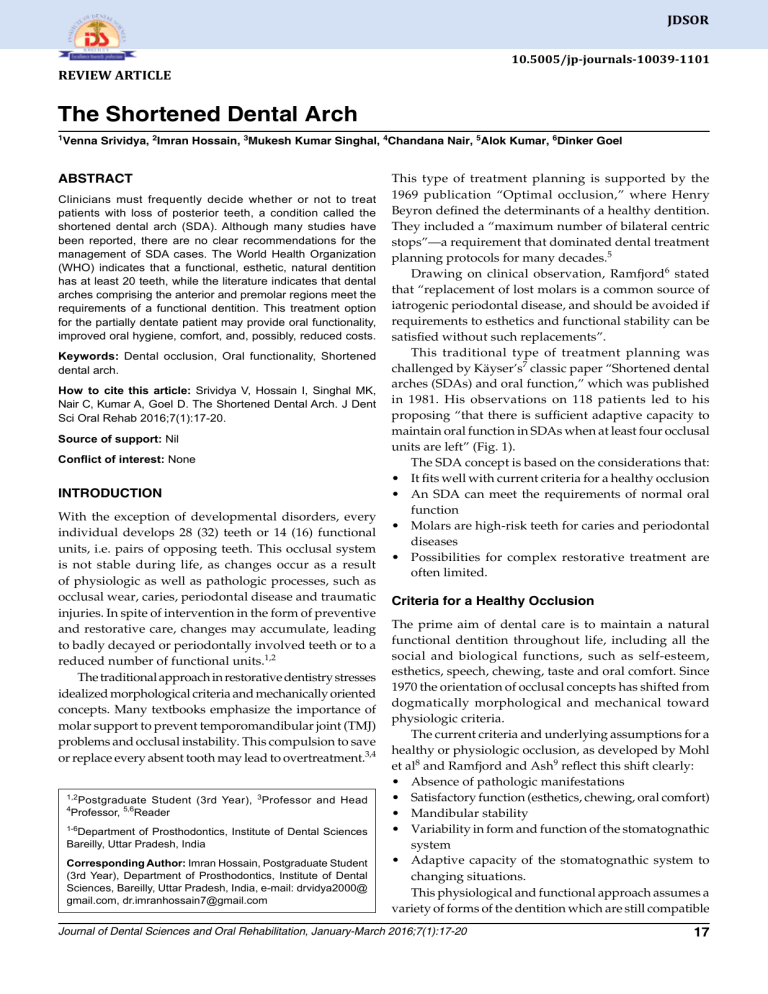
JDSOR 10.5005/jp-journals-10039-1101 The Shortened Dental Arch REVIEW ARTICLE The Shortened Dental Arch 1 Venna Srividya, 2Imran Hossain, 3Mukesh Kumar Singhal, 4Chandana Nair, 5Alok Kumar, 6Dinker Goel ABSTRACT Clinicians must frequently decide whether or not to treat patients with loss of posterior teeth, a condition called the shortened dental arch (SDA). Although many studies have been reported, there are no clear recommendations for the management of SDA cases. The World Health Organization (WHO) indicates that a functional, esthetic, natural dentition has at least 20 teeth, while the literature indicates that dental arches comprising the anterior and premolar regions meet the requirements of a functional dentition. This treatment option for the partially dentate patient may provide oral functionality, improved oral hygiene, comfort, and, possibly, reduced costs. Keywords: Dental occlusion, Oral functionality, Shortened dental arch. How to cite this article: Srividya V, Hossain I, Singhal MK, Nair C, Kumar A, Goel D. The Shortened Dental Arch. J Dent Sci Oral Rehab 2016;7(1):17-20. Source of support: Nil Conflict of interest: None INTRODUCTION With the exception of developmental disorders, every individual develops 28 (32) teeth or 14 (16) functional units, i.e. pairs of opposing teeth. This occlusal system is not stable during life, as changes occur as a result of physiologic as well as pathologic processes, such as occlusal wear, caries, periodontal disease and traumatic injuries. In spite of intervention in the form of preventive and restorative care, changes may accumulate, leading to badly decayed or periodontally involved teeth or to a reduced number of functional units.1,2 The traditional approach in restorative dentistry stresses idealized morphological criteria and mecha­nically oriented concepts. Many textbooks emphasize the importance of molar support to prevent temporomandibular joint (TMJ) problems and occlusal instability. This compulsion to save or replace every absent tooth may lead to overtreatment.3,4 1,2 4 Postgraduate Student (3rd Year), 3Professor and Head Professor, 5,6Reader 1-6 Department of Prosthodontics, Institute of Dental Sciences Bareilly, Uttar Pradesh, India Corresponding Author: Imran Hossain, Postgraduate Student (3rd Year), Department of Prosthodontics, Institute of Dental Sciences, Bareilly, Uttar Pradesh, India, e-mail: drvidya2000@ gmail.com, [email protected] This type of treatment planning is supported by the 1969 publication “Optimal occlusion,” where Henry Beyron defined the determinants of a healthy dentition. They included a “maximum number of bilateral centric stops”—a requirement that dominated dental treatment planning protocols for many decades.5 Drawing on clinical observation, Ramfjord6 stated that “replacement of lost molars is a common source of iatrogenic periodontal disease, and should be avoided if requirements to esthetics and functional stability can be satisfied without such replacements”. This traditional type of treatment planning was challenged by Käyser’s7 classic paper “Shortened dental arches (SDAs) and oral function,” which was published in 1981. His observations on 118 patients led to his proposing “that there is sufficient adaptive capacity to maintain oral function in SDAs when at least four occlusal units are left” (Fig. 1). The SDA concept is based on the considerations that: • It fits well with current criteria for a healthy occlusion • An SDA can meet the requirements of normal oral function • Molars are high-risk teeth for caries and periodontal diseases • Possibilities for complex restorative treatment are often limited. Criteria for a Healthy Occlusion The prime aim of dental care is to maintain a natural func­tional dentition throughout life, including all the social and biological functions, such as self-esteem, esthetics, speech, chewing, taste and oral comfort. Since 1970 the orientation of occlusal concepts has shifted from dogmatically morphological and mechanical toward physiologic criteria. The current criteria and underlying assumptions for a healthy or physiologic occlusion, as developed by Mohl et al8 and Ramfjord and Ash9 reflect this shift clearly: • Absence of pathologic manifestations • Satisfactory function (esthetics, chewing, oral comfort) • Mandibular stability • Variability in form and function of the stomatognathic system • Adaptive capacity of the stomatognathic system to changing situations. This physiological and functional approach assumes a variety of forms of the dentition which are still compatible Journal of Dental Sciences and Oral Rehabilitation, January-March 2016;7(1):17-20 17 Venna Srividya et al Fig. 1: An illustrative example of a shortened maxillary dental arch. This particular patient presented with stable occlusal conditions 25 years after the extraction of the molars with healthy occlusion and satisfying oral function. An important implication is that the number of teeth may vary, and thus may be less than 28. Shortened Dental Arches An SDA is a specific type of a dentition with a reduced number of posterior dental units, namely a dentition with a reduction of teeth starting posteriorly. To provide care for the partially-dentate patient, the factors considered are: • Oral functionality • Vertical dimension • Occlusion • Maintenance of hard tissue • Temporomandibular joint health • Patient comfort. Oral functionality is defined in this article as the maintenance of masticatory ability and efficiency while preserving the health of soft and hard tissues (Fig. 2).10-12 The literature indicates that masticatory ability is closely related to the number of teeth, and there is impaired masticatory ability when the patient has less than 20 well-distributed teeth.10,13 In this context, the SDA may be defined as having an intact anterior region but a reduced number of occluding pairs of posterior teeth.14 In 1992, the World Health Organization (WHO) stated that the retention, throughout life, of a functional, esthetic, natural dentition of not less than 20 teeth and not requiring recourse to prostheses should be the treatment goal for oral health.15 It is not possible, however, to quantify the minimum number of teeth needed to satisfy functional demands because these demands vary from individual to individual. Furthermore, both dental and financial considerations strongly influence the treatment plan, and, in fact, dental arches comprising the anterior and premolar regions meet the requirements of a functional dentition.7,15 It follows that the replacement of missing molar teeth by cantilevers, resin-bonded fixed partial dentures, implant-supported prostheses, or distal extension removable partial dentures may amount to over-treatment for patients with SDAs. Masticatory Efficiency Masticatory efficiency and masticatory ability are impor­ tant components of oral functionality, but patient adap­ tation to changes in dental arch length with progressive loss of teeth is critical to successful treatment. They can be separated into two broad categories, sub­ jective and objective evaluations.5,10 Subjective masticatory function or masticatory ability usually is evaluated through interviews with patients assessing their own masticatory functionality. Objective evaluation of masticatory function or masticatory efficiency commonly involves measurement of the patient’s ability to grind food. Overall, the literature indicates that masticatory ability closely correlates with the number of teeth and is impaired when there are fewer than 20 uniformly distributed teeth in the mouth.8 Fig. 2: Representation of SDAs, comprising an intact anterior region and a variation of arch length, expressed in occlusal units (OU), i.e. pairs of occluding posterior teeth; one molar unit is considered to be equal to two premolar units 18 JDSOR The Shortened Dental Arch An early study involving a cross-sectional clinical investi­gation of 118 patients separated into 6 groups according to the length and symmetry of the SDA. The study suggested that there is sufficient adaptive capacity for patients to maintain adequate oral function in SDAs provided at least 4 occlusal units remain, although these must be symmetrically placed.15 Thus, impaired masticatory ability and associated changes or shifts in food selection are manifested only when there are less than 10 pairs of occluding teeth. Prosthodontic Considerations Prosthodontic considerations in patient treatment are occlusal stability, establishing the correct vertical dimen­ sion, and preserving the health of the soft and hard tissues as well as that of the TMJ. Occlusal stability is defined as the absence of the ten­dency for teeth to migrate other than the normal phy­siologic compensatory movements occurring over time,16,17 a better definition may be the stability of tooth posi­tioning relative to its spatial relationship in the occluding dental arches.8 Occlusal stability is determined by a number of factors: • Periodontal support • The number of teeth in the dental arches • Interdental spacing • Occlusal contacts • Tooth wear. Distal tooth migration occurs in SDAs, and this may result in an increased anterior load which, in turn, increases the number and intensity of anterior occlusal contacts as well as the interdental spacing.15 Such effects may be exacerbated when unopposed teeth and lonestanding teeth have inadequate periodontal support. Likewise, tooth migration can cause changes in the vertical and horizontal overlap, occlusal wear, and loss of posterior support, among other effects. Occlusal stability is thought to be reduced with extre­ mely short dental arches, i.e. only 0 to 2 pairs of occluding premolars. While occlusal stability is reported to be greater with longer dental arches, i.e. 3 to 4 occluding units, older patients generally experience increased changes in occlusal integrity.15 Overall, SDAs comprising anterior and premolar teeth satisfy oral functional demands and show similar vertical overlap and occlusal tooth wear patterns to those found with complete dental arches.18 While patients with SDAs have more interdental premolar spacing, greater occlusal contact of anterior teeth, and lower alveolar bone scores (i.e. the alveolar bone height at the distal surface of each premolar8), the differences in dentition and occlusal characteristics from those of complete or longer dental arches appear to change little over time.15 This suggests that the SDA, in fact, is characterized by long-term occlusal stability. While there was no evidence that SDAs provoke TMJ problems, it was noted that the risk for pain and joint sounds increased when unilateral or bilateral posterior support is missing.18 Overall, the findings indicated that the SDA concept has a role in contemporary clinical practice. Treatment options and alternatives as the number of remaining teeth decreases, considerations of oral func­ tionality, prosthodontic treatment, and patient comfort become increasingly important. In other words, does the SDA and reduced food platform area compromise masticatory ability and/or efficiency or adversely influence food selectivity? While restoration of the complete dental arch (i.e. up to and including the second molars) is desirable, this treatment option may not be practical or possible for every patient while occasionally being prohibited by financial constraints. Furthermore, complete dental arch restoration may be inadvisable for compromised and high-risk patients, such as immunosuppressed patients and those undergoing radiotherapy, chemotherapy or both. Nevertheless, the question remains as to what is an adequate and reasonable standard of treatment for the partially dentate patient with the obvious corollary of whether the cost of treatment is justified by the perceived and/or actual clinical outcome. Acceptable oral health throughout life is the retention of a functional, esthetic, natural dentition of not less than 20 teeth and not requiring recourse to prostheses. This implies that adult patients have adequate oral functionality when the most posterior teeth are the second premolars. The concept of the shortened but functional dental arch addresses this issue, and the literature indicates that the SDA does not contradict current occlusion theories while offering some important advantages. In particular, the SDA protocol decreases the emphasis on restorative treatments for the posterior regions of the mouth. In other words, the SDA may avoid the risk of overtreatment of the patient while still providing a high standard of care and minimizing cost. The shortened dental arch therapy protocol terminates the occlusal platform at the second premolar region. This may be beneficial for the implant patient since no posterior implants are needed; thereby simplifying both the surgical implant placement and its restoration. Likewise, the SDA protocol may be beneficial for the high-risk patient in that restricting the dental arch length reduces the treatment regimen without compromising oral functionality. Journal of Dental Sciences and Oral Rehabilitation, January-March 2016;7(1):17-20 19 Venna Srividya et al SUMMARY The literature indicates that dental arches comprising the anterior and premolar regions meet the requirements of a functional dentition. However, functional demands, and the number of teeth to satisfy such demands, vary with the individual and, consequently, dental treatment must be tailored to each individual’s needs and adaptive capability. By offering the partially dentate patient a treatment option that ensures oral functionality, improved oral hygiene, comfort, and possibly reduced costs, the SDA treatment approach appears to provide an advantage without compro­mising patient care. The SDA concept does not contradict current occlusion theories and appears to fit well with the problem-solving approach favored in modern dentistry. Advocating the SDA offers some important advantages, one of which may be a decreased emphasis on restorative treatments for the posterior regions of the mouth. REFERENCES 1. Kayser A. Shortened dental arch: a therapeutic concept in reduced dentitions and certain high-risk groups. Int J Periodon Restor Dent 1989;9(6):426. 2. Kalk W, Käyser A, Witter D. Needs for tooth replacement. Int Dent J 1993;43(1):41-49. 3. Elderton R. Overtreatment with restorative dentistry: when to intervene? Int Dent J 1993;43(1):17-24. 4. Käyser A, Witter D, Spanauf A. Overtreatment with removable partial dentures in shortened dental arches. Aust Dent J 1987;32(3):178-182. 5. Beyron H. Optimal occlusion. Dent Clin North Am 1969;13(3):537-554. 20 6. Ramfjord SP. Periodontal aspects of restorative dentistry. J Oral Rehabil 1974;1(2):107-126. 7. Käyser A. Shortened dental arches and oral function. J Oral Rehabil 1981;8(5):457-462. 8. Mohl N, Zarb G, Carlsson G, Rugh J. A Textbook of occlusion. Chicago: Quintessence Publ Co. Inc; 1988. 9. Ramfjord S, Ash M. Occlusion Philadelphia: Saunders Co.; 1966. 10. Witter D, Haan A, Käyser A, Rossum G. A 6-year follow-up study of oral function in shortened dental arches—part I: occlusal stability. J Oral Rehabil 1994;21(2):113-125. 11. Witter DJ, Palenstein Helderman WH, Creugers NH, Käyser AF. The shortened dental arch concept and its impli­ cations for oral health care. Community Dent Oral Epidemiol 1999;27(4):249-258. 12. Van der Bilt A, Olthoff L, Bosman F, Oosterhaven S. The effect of missing postcanine teeth on chewing performance in man. Arch Oral Biol 1993;38(5):423-429. 13. Rodriguez AM, Aquilino SA, Lund PS. Cantilever and implant biomechanics: a review of the literature—part 2. J Prosthodont 1994;3(2):114-118. 14. Rosenoer L, Sheiham A. Dental impacts on daily life and satisfaction with teeth in relation to dental status in adults. J Oral Rehabil 1995;22(7):469-480. 15. Sarita PT, Witter DJ, Kreulen CM, Van’t Hof MA, Creugers NH. Chewing ability of subjects with shortened dental arches. Community Dent Oral Epidemiol 2003;31(5): 328-334. 16. Witter D, Haan A, Käyser A, Rossum G. A 6-year followup study of oral function in shortened dental arches—part II: craniomandibular dysfunction and oral comfort. J Oral Rehabil 1994;21(4):353-366. 17. Witter D, Cramwinckel A, Van Rossum G, Käyser A. Shortened dental arches and masticatory ability. J Dent 1990;18(4):185-189. 18. Witter D, Creugers N, Kreulen C, De Haan A. Occlusal stability in shortened dental arches. J Dent Res 2001;80(2):432-436.
